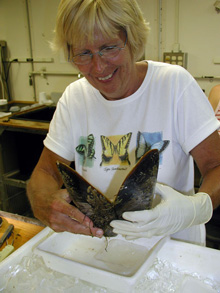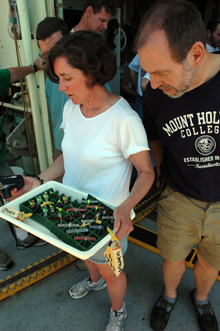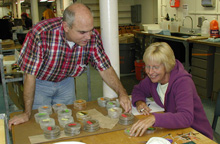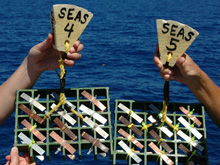
After dissecting several hundred smelly sulfide-laden mussels, middle school teacher Cindy Petersen is still all smiles! Click image for larger view and image credit.
TDI-Brooks geochemist Bernie Bernard gives Cindy Petersen a chemistry lesson about the oxidation rates of various metals. Petersen will incorporate these lessons-learned into the Student Experiments at Sea (SEAS) oxidation lab. Click image for larger view and image credit.
It's for the Kids!
May 28, 2006
Liz Goehring
Penn State University
Ridge2000 Education Outreach
26 23.36 N
094 30.87 W
What are two teachers doing on a research cruise in the Gulf of Mexico? Cooking up ways to get kids interested the deep sea and involved in science — that’s what! Although trained in science, we’re not your typical members of this research party, and often get quizzical looks when we try some simple ship-board experiment. Our reminder, “It’s for the kids,” inevitably changes those looks to grins accompanied with offers of assistance.
I have a great job. As the education and outreach coordinator for a major deep-sea research initiative studying vents and cold seeps, my role is to work with this community of scientists to help translate their discoveries for other audiences. To do so, I first need to understand what these folks study and how they go about doing it, and this involves going to sea. The cold-seep and hot-vent environments are complex and require sophisticated equipment and interdisciplinary teamwork to unravel their mysteries. On this cruise, we have geologists and physical oceanographers, along with microbiologists, geochemists, and biologists, all working together, collecting and sharing samples like pieces of a giant puzzle. Living and working side-by-side these folks, as well as with the ship’s crew and the deep submergence vehicle (DSV) Alvin pilots, I have the perfect opportunity to understand the science and begin the translation. Still, I think, "Oh, if only we could bring students out here!"
I used to be a science teacher, so naturally my favorite "other audience" is students. I’m constantly thinking of ways to bring this extreme environment to the classroom and to use the excitement of discovery to spark students’ curiosity and engage them in scientific thinking. After all, science is about exploring our world and challenging our preconceptions (and misconceptions!) to come up with explanations for what we observe. Deep-sea research offers the perfect setting. Just this morning, for example, I had the opportunity to watch yesterday’s video footage of the DSV Alvin diving on a brine pool at the bottom of the ocean. You could see waves of this supersaturated fluid slowly washing up on the "shoreline" of this pool. I had to keep reminding myself that this was all taking place under a mile of ocean water! What a great lesson on density and the properties of fluids!
As compelling as this environment is, however, getting middle and high school students engaged in scientific thinking is not an automatic given. The environment is remote. Watching video footage and hearing scientists’ explanations is not unlike watching TV. But, invite students to participate, and things change. Suddenly, science becomes real. When I taught, I found that when kids were given the opportunity to do science— that is to ask their own questions and devise experiments to test their ideas — they became engaged. Kids are naturally curious, and the scientific process offers a structured way to explore that curiosity, to make observations, test ideas and develop explanations based on evidence. “Doing science” is the philosophy behind the Student Experiments at Sea (SEAS) program.

Immediately after the deep submergence vehicle (DSV) Alvin recovery, Liz Goehring holds the recovered "Classroom to Sea" RUST experiment. Students will run similar experiments in their classrooms and compare their data to those collected during the cruise by Liz and Cindy. Click image for larger view and image credit.
SEAS (www.ridge2000.org/SEAS/ ![]() ) is a Web-based education program in which students are invited to participate in the research process of deep-sea science. The power of the Internet enables students to access the remote deep-sea environment and the scientists working there. SEAS focuses on “Classroom to Sea” labs in which students conduct labs in their classroom that parallel work conducted at sea. The labs are designed to enable students to compare datasets and develop an understanding of similarities and differences between the two environments. Scientist Spotlights also feature research questions and techniques related to the lab. The Classroom to Sea labs serve as springboards for further student investigations.
) is a Web-based education program in which students are invited to participate in the research process of deep-sea science. The power of the Internet enables students to access the remote deep-sea environment and the scientists working there. SEAS focuses on “Classroom to Sea” labs in which students conduct labs in their classroom that parallel work conducted at sea. The labs are designed to enable students to compare datasets and develop an understanding of similarities and differences between the two environments. Scientist Spotlights also feature research questions and techniques related to the lab. The Classroom to Sea labs serve as springboards for further student investigations.
During this cruise, I’ve brought along another teacher, Cindy Petersen, to help develop new labs. Cindy is a real veteran in getting students to conduct their own research in classroom settings. We have been augmenting the current Classroom to Sea mussel lab, adding a new dataset on seep mussels. We are also developing two new labs, one focusing on oxidation in the deep for an Earth science or chemistry classroom, and another on biodiversity. The possibilities are endless, and we are limited only by the numbers of hours in the day.
SEAS is available for anyone with an Internet connection and a curiosity about the deep-sea environment. The program was developed with National Science Foundation (NSF) funding, along with the contributions of many deep-sea scientists who understood the importance of the reminder, “It’s for the kids!”
Sign up for the Ocean Explorer E-mail Update List.






























